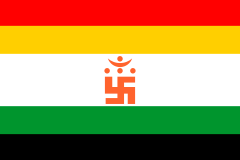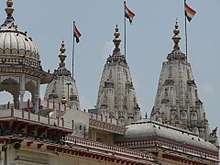Jain flag

| Part of a series on |
| Jainism |
|---|
 |
|
Jain prayers |
|
Ethics |
|
Major sects |
|
Festivals |
|
|
The flag of Jainism has five colours: orange or red, yellow, white, green and black or dark blue. These five colours represent the Pañca-Parameṣṭhi (five supreme beings). It also represents the five main vows, small as well as great.
Overview
Colours
These five colours represent the "Pañca-Parameṣṭhi" and the five vows, small as well as great:[1]
- White - represents the arihants, souls who have conquered all passions (anger, attachments, aversion) and have attained omniscience and eternal bliss through self-realization. It also denotes peace or ahimsa (nonviolence).
- Red - represents the siddha, souls that have attained salvation and truth. It also denotes truthfulness (satya).
- Yellow - represents the acharya the Masters of Adepts. The colour also stands for non-stealing (achaurya).[1]
- Green - represents the upadhyaya (adepts), those who teach scriptures to monks. It also signifies chastity (brahmacharya).[1]
- Dark blue or black - represents the sadhus and sadhvis or monks and nuns. It also signifies non-possession.
It is also believed that the complexion of all the 24 Tirthankaras was of one of these 5 colours. For instance, Chandraprabha and Pushpadanta were white, Munisuvrata and Neminatha were blue or dark colour, Padmaprabha and Vasupujya were red, Mallinatha and Pārśva were green, while the remaining were golden or yellowish.
Swastika
The swastika in the centre of the flag represents the four states of existence of soul. The four stages may be:
- heaven-beings or deities
- human beings
- animal/birds/insects/plants
- hell beings
It represents that the soul can embody any of these forms, owing to karma, which may escalate it to higher-level forms such as heavenly beings, or degrade it to lower-level forms such as lesser animals or hell beings.
The purpose of soul is to liberate itself from these four stages and be arihants or Siddha eventually.
Three Dots
The three dots above the swastika represent the Ratnatraya (three jewels) of Jainism:
- Samyak Darshana - "Right Faith" or "Right Vision"
- Samyak Gyana - "Right Knowledge"
- Samyak Charita - "Right Conduct"
These are part of the Jainist paradigm by which jīva (living souls) seek to rid themselves of karma and the cycle of rebirth, saṃsāra, which it develops.
Siddhashila Chakra
The curve above the three dots denotes Siddhashila, a place in the highest realms of Universe, composed of pure energy. It is above hell, earth, or heaven. It is the place where souls that have attained salvation, for instance, Arihants and Siddhas reside eternally with supreme bliss.
Respect for Jain Flag is respect for Pañca-Parameṣṭhi (Supreme Five). According to Jainism, respect for Pañca-Parameṣṭhi abiding the Ratnatraya (Three Jewels) destroys the sorrow of the four states of existence and finally guides one to the sweet home of infinite bliss (Siddhashila).
Photo gallery
 Flag atop the Gingee Jain temple, Gingee, Villupuram district, Tamil Nadu, India
Flag atop the Gingee Jain temple, Gingee, Villupuram district, Tamil Nadu, India Flag atop the Shri Mahavirji temple, Rajasthan, India
Flag atop the Shri Mahavirji temple, Rajasthan, India
See also
References
- 1 2 3 Jain, Vijay K. (2012). Acharya Amritchandra's Purushartha Siddhyupaya. Vikalp Printers. p. iv. ISBN 81-903639-4-8.
